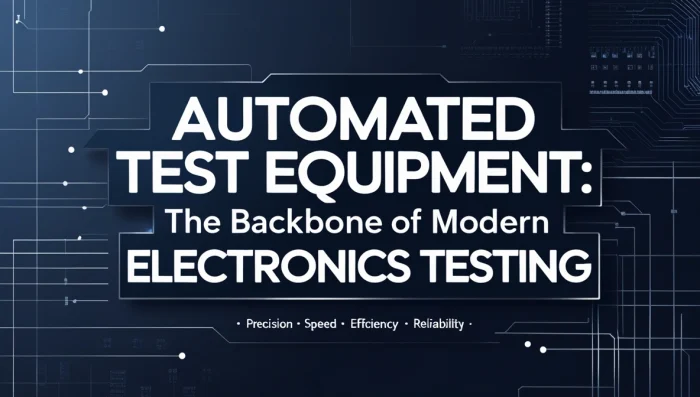In today’s fast-paced electronics manufacturing world, ensuring product quality and reliability is paramount. This is where automated test equipment (ATE) becomes a vital asset. It streamlines the testing of electronic components and assemblies, allowing companies to maintain high standards, reduce costs, and accelerate time to market.

This article provides an in-depth look at automated test equipment, its features, benefits, and its crucial role across various industries.
Content
What Is Automated Test Equipment?
Automated test equipment refers to computer-controlled systems designed to evaluate the functionality and performance of electronic devices. These systems automate a range of tests on semiconductors, printed circuit boards (PCBs), and finished products to detect defects, ensure compliance, and verify specifications.
Unlike manual testing, ATE offers speed, repeatability, and precision, making it indispensable for high-volume production environments where consistency is critical.
Core Components and Features of Automated Test Equipment
Modern ATE systems comprise several key components that work together seamlessly:
- Test Instruments: Oscilloscopes, signal generators, power supplies, and multimeters provide measurements and stimulus signals.
- Test Head and Fixture: Connects the device under test (DUT) to the system.
- Controller: Runs software to execute test programs and analyze results.
- User Interface: Allows operators to monitor testing and adjust parameters.
Key Features Include:
- Modularity and Scalability: Systems can be expanded or reconfigured to accommodate different devices or testing needs.
- High Throughput: Capable of performing rapid tests to keep up with manufacturing lines.
- Data Logging and Analysis: Stores results for quality tracking and root cause analysis.
- Support for Multiple Technologies: Tests analog, digital, RF, and mixed-signal devices.
Advantages of Using Automated Test Equipment
1. Improved Product Quality
ATE enables early detection of manufacturing defects, preventing faulty products from reaching customers. Consistent and precise testing leads to higher reliability and customer satisfaction.
2. Increased Testing Efficiency
Automating repetitive tests reduces cycle times and eliminates human error. This improves throughput and allows manufacturers to meet tight production schedules.
3. Cost Savings
While initial investments in ATE can be significant, the long-term benefits include reduced labor costs, less scrap and rework, and minimized warranty claims.
4. Detailed Data Collection
Automated systems generate comprehensive reports that help engineers identify trends and optimize production processes.
5. Versatility
From simple components to complex systems, automated test equipment adapts to diverse testing requirements, making it a flexible tool for manufacturers.
Applications of Automated Test Equipment Across Industries
Automotive Electronics

Modern vehicles rely heavily on electronic control units (ECUs), sensors, and communication modules. ATE ensures these components function correctly under stringent safety and reliability standards.
Consumer Electronics

Smartphones, tablets, and smart home devices undergo rigorous testing using automated equipment to verify battery life, signal integrity, and user interface responsiveness.
Aerospace and Defense

In aerospace, reliability is critical. Automated test solutions validate communication systems, avionics, and navigation equipment to meet regulatory and operational demands.
Medical Devices

Medical electronics such as monitors, imaging machines, and diagnostic tools require precise testing to ensure patient safety and regulatory compliance.
The Automated Test Process: Step-by-Step
Understanding the automated test workflow helps clarify its benefits:
- Test Program Development
Engineers write test sequences based on device specifications. These programs instruct the ATE system on how to stimulate and measure the DUT. - Setup and Calibration
Before production, the system is configured and calibrated to guarantee measurement accuracy. - Testing
Devices move through the test station where the ATE executes the programmed tests automatically. - Data Collection and Analysis
Results are recorded and analyzed. Pass/fail criteria are applied to sort devices. - Reporting and Feedback
Test reports guide quality control and process improvement initiatives.
Emerging Trends in Automated Test Equipment
The landscape of automated testing continues to evolve with technological advances:
- Integration with Artificial Intelligence (AI): AI algorithms enhance test program optimization and predictive maintenance.
- Cloud Connectivity: Enables real-time monitoring and data sharing across global production sites.
- Support for IoT Devices: ATE adapts to test connectivity and interoperability challenges in the Internet of Things ecosystem.
- Miniaturization and Portability: Compact systems allow on-site testing in diverse environments.
Challenges and Considerations
While ATE offers many benefits, manufacturers must consider:
- High Initial Cost: Equipment purchase and programming require investment.
- Complexity: Skilled personnel are needed to develop and maintain test programs.
- Customization Needs: Specific applications may require tailored solutions.
Conclusion
Automated test equipment is a cornerstone technology that ensures electronic products meet demanding quality and performance standards. Its ability to deliver fast, accurate, and repeatable testing makes it essential in industries ranging from automotive to healthcare.
By leveraging the benefits of ATE, manufacturers can improve efficiency, reduce costs, and enhance product reliability—driving innovation forward in the electronics world.
If you want to learn about different technologies and gadgets, you can visit our website funtechblog
Frequently Ask Question
What is Automated Test Equipment?
Automated Test Equipment (ATE) refers to computer-controlled systems designed to test electronic components for functionality, performance, and possible defects. These systems carry out a series of diagnostic tests automatically, without the need for manual input. ATE is essential in identifying faults early in the production process and is widely used in testing semiconductors, printed circuit boards (PCBs), and other electronic assemblies. It is especially critical in high-volume manufacturing environments where speed, consistency, and precision are vital.
Which Tool Is Used for Automation Testing?
In the electronics industry, tools such as Teradyne, Advantest, and National Instruments (NI) are widely used for automated hardware testing. These platforms are tailored to specific sectors like automotive, aerospace, consumer electronics, and telecommunications. For software testing, commonly used automation tools include Selenium, JUnit, and TestComplete, which help streamline application testing across development environments.
What Is the Purpose of ATE?
The main purpose of Automated Test Equipment is to efficiently detect defects, verify performance, and ensure the reliability of electronic devices. By automating the testing process, ATE reduces manual effort, improves accuracy, and shortens testing time. This not only enhances production speed but also lowers the risk of human error—making it a scalable and cost-effective solution for electronics manufacturers.
What Is ATE in Engineering?
In the field of engineering, ATE stands for Automated Test Equipment and is extensively applied in electrical, electronics, and systems engineering disciplines. Engineers use ATE systems to test prototypes, verify the integrity of final products, and conduct routine quality assurance. It also plays a crucial role in compliance testing and life cycle evaluation, helping engineers meet regulatory standards and performance benchmarks.

Joel Broussard is an avid blogger on technology, gadgets, and other topics that interest him. He likes to write about his personal experiences with the latest tech products as well as offer advice for people who are looking to buy a new device. When he is not blogging you can find him at home playing video games or watching anime.







